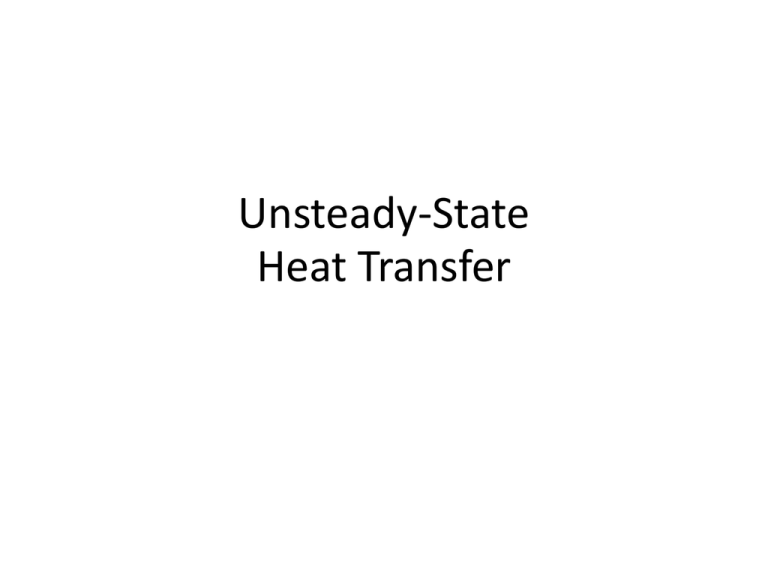Ch3_HeatTransfer_6
advertisement

Unsteady-State Heat Transfer Unsteady state or transient heat transfer • Phase of heating and cooling process when the temperature is changing with time • During this phase, temperature is a function of both location and time. • Steady state : temperature varies only with location Simplified geometrical shapes • Sphere • Infinite cylinder • Infinite slab Example • Food pasteurization • Food sterilization • Food refrigeration/chilling/cooling Partial differential equation • For a one-dimensional case, temperature is a function of two independent variables, time and location : Thermal diffusivity or Important of external versus internal resistance to heat transfer • During unsteady state heating period, temperature in side a solid object (initially at a uniform temp.) will vary with location and time. Assuming the location of interest is at center of solid, heat transfer from to fluid to center will encounter two resistance Conductive resistance inside solid Convective resistance in fluid layer Internal resistance to heat transfer External resistance to heat transfer NBi = D/k = hD 1/h k D = characteristic dimension = NBi (Biot number) = NBi Three cases for unsteady-state heat transfer • NBi < 0.1 : negligible internal resistance to heat transfer • 0.1 < NBi < 40 : finite internal and surface resistance to heat transfer • NBi > 40 : negligible surface resistance to heat transfer Negligible internal resistance to heat transfer NBi < 0.1 Example Finite internal and surface resistance to heat transfer 0.1 <NBi < 40 Solution • Temperature-time charts – Dimensionless number K t t Fourier number = NFo = = 2 2 Cp D D NBi = D/k = hD 1/h k Ta–T = temperature ratio Ta–Ti (Ta–T) (Ta–Ti) 1/NBi NFo = t / D2 (Ta–T) (Ta–Ti) 1/NBi NFo = t / D2 (Ta–T) (Ta–Ti) 1/NBi NFo = t / D2 • For calculation of temperature at any position of the object, Gurney-Lurie Chart can be used. Gurney-Lurie Chart • The chart shows how four different dimensionless groups depend on each other. • For any given values of three of the groups the fourth can be read of the chart. • As stated earlier the X term the time (t) and the thermal diffusivity (α) is being divided by the radius (r) squared. In short n stands for the "depth", that is the length (x) divided by the total length (x0) or for cylinders and spheres the radius (r). The last term m is the relationship between the thermal Negligible surface resistance to heat transfer NBi > 40 • Use temperature-time chart. • The lines for k/hD or 1/NBi = 0 represent negligible surface resistance to heat transfer (Ta–T) (Ta–Ti) 1/NBi NFo = t / D2 Finite objects Example 1 • Estimate the time when temperature at the geometric center of a 6 cm diameter apple held in 2C water stream reaches 3C. The initial uniform temperature of the apple is 15C. The convective heat transfer coefficient in water surrounding the apple is 50 W/m2C. The properties of the apple are thermal conductivity k = 0.355 W/mC, specific heat Cp = 3.6 kJ/kgC, and density = 820 kg/m3. (Ta–T) (Ta–Ti) 1/NBi TR = 0.077 1/NBi = 0.237 NFo = t / D2 Example 2 • Estimate the temperature at the geometric center of a food product contained in a 303X406 can exposed to boiling water at 100C for 30 min. The product is assumed to heat and cool by conduction. The initial uniform temperature of product is 35C. The properties of the food are thermal conductivity k = 0.34 W/mC, specific heat Cp = 3.5 kJ/kgC, and density = 900 kg/m3. The convective heat transfer coefficient for boiling water is estimated to be 2000 W/m2C. Finite objects (Ta–T) (Ta–Ti) 1/NBi NFO = 0.118 1/NBi = 0.004 NFo = t / D2 (Ta–T) (Ta–Ti) 1/NBi NFo = t / D2 NFO = 0.064 1/NBi = 0.03 Example 3 A rectangular slab of butter which is 46.2 mm thick at a temperature of 4.4C in a cooler is removed and placed in an environment at 23.9C. The sides and bottom of the butter container can be considered to be insulated by the container side walls. The flat top surface of the butter is exposed to the environment. The convective heat transfer coefficient is constant and is 8.52 W/m2K. Calculate the temperature in the butter at the surface, at 25.4 mm below the surface, and at 46.2 mm below the surface at the insulated bottom after 5 h of expose. The physical properties of butter are thermal conductivity k = 0.197 W/m.K, specific heat Cp = 2.30 kJ/kg.K, and density = 998 kg/m3.











